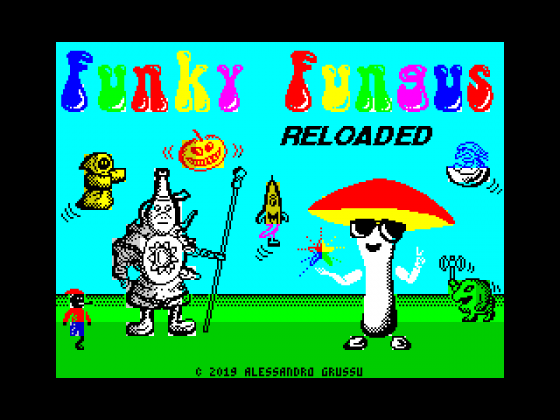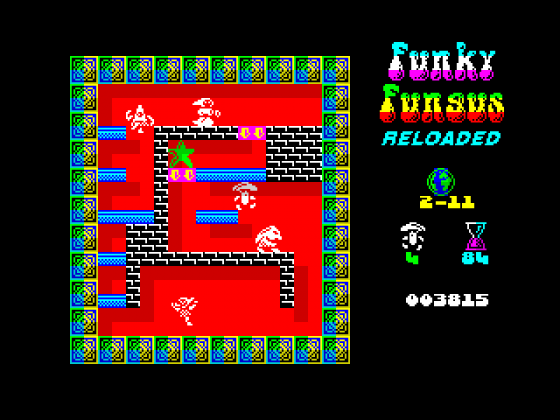
Alessandro Grussu
 9th January 2022
9th January 2022
Categories: Game Development Log
Author: Alessandro Grussu
Published in Al's Spectrum Annual 2021
Behind The Scenes: Fungus Reloaded
When Funky Fungus first appeared on Easter 2013, it represented my attempt to create something reminiscent of old single-screen platform coin-ops where you have to eliminate all enemies to access the next screen. For the time, this was a significant advance - it was the first multi-level game for 128K made with Arcade Games Designer; each level, called "world", was in fact a single game put together with this tool. It was my first game introduced by a presentation, too. The reception was pretty good: the most appreciated features were the sprites' graphic style and the wide variety of the screens, which made the game an arcade with a touch of puzzle, since each screen requires a different tactic to be negotiated. In some of them you must start at once, in others you have to be patient and wait for the right moment to move.
The main criticism, on the other hand, was focused on the excessive difficulty, which was also noticed by those who had played my two previous titles, Lost In My Spectrum and Apulija-13. I had not yet learned how to calibrate this aspect well, and since I do not like games that can be finished in an afternoon, I made them arduous to say the least. Then there was the fact that early versions of AGD handled collision detection in a rather inaccurate way, and every so often Funky lost a life in a situation where, without this inconvenience, this would not have happened. Finally, the very first version used the M: disk or RAM Disk to store the four worlds, but this made it incompatible with DivIDE type interfaces.
Therefore, I released a revised version a few months later, which included an Assembly routine, developed after several attempts and an exchange of ideas on the World Of Spectrum forum. The routine, which I have used in all my games for 128K since then, keeps levels in the memory banks (in compressed form to make them stay within the limit of 16 Kb), from where it recalls them as needed, all in USR 0 mode to ensure compatibility with the DivIDE. Other revisions concerned sprites and minimum collision distance; although improved, it was still not as precise as I intended.
Funky Fungus continued to seem to me, despite the improvements, a "diamond in the rough", a potential not fully expressed. Being not yet completely satisfied with the result, I considered the possibility of revising it further, but I began to dedicate myself to Cousin Horace, an even more ambitious project, and left it aside for a long time.
Almost six years later, in March 2019, Felipe Monge contacted me about the Power Up! Action Pack project, the collection of recent games to be released on the Dandanator cartridge (see page 42), and asked me if I was interested in contributing to it.
That was an opportunity to dust off Funky Fungus and relaunch it in style. I had the two Sophia games under my belt; they both enjoyed a very good reception, and I would have used the experience they allowed me to gather to finalise what had been left to do such a long time before. To emphasise the differences from the original game, I added Reloaded to the title. The changes, extensions and improvements that separate the two games are really many: the new user interface entirely coded in Assembly, eight more screens, background music inspired by the masters of funk/jazz from the 60s-70s, flashing and bigger stars, more accurate collision detection, redesigned enemies, the death animation for Funky, the codes for replaying each world, the high score table...
Initially I thought of distributing Reloaded only after the release of Power Up! Action Pack, but the onset of the Covid-19 pandemic had the effect of slowing down that project, and since Easter was approaching, I wanted to take advantage of it to launch the game right in occasion of that holiday, as I had done seven years earlier for the old Funky Fungus. Felipe kindly agreed, and so it was that on Sunday, 12 April 2020, Funky Fungus returned to the screens, bolder than before.
As I previously did with Lost In My Spectrum and Apulija-13, I was oriented to withdraw from the archives of World Of Spectrum and Spectrum Computing the old version of Funky Fungus as well, as I wanted users to play only Reloaded. It was Arnau Jess who suggested me not to eliminate the possibility of downloading the old Funky Fungus, so that players would realise the extent of the changes made in Reloaded. So I did, although at the time of release I made it clear that this was the Funky Fungus I would have made seven years before, had I at my disposal the means and experience that I had now.
For this reason, I wish players to focus on Reloaded, rather than the previous one, which has a purely historical value.



